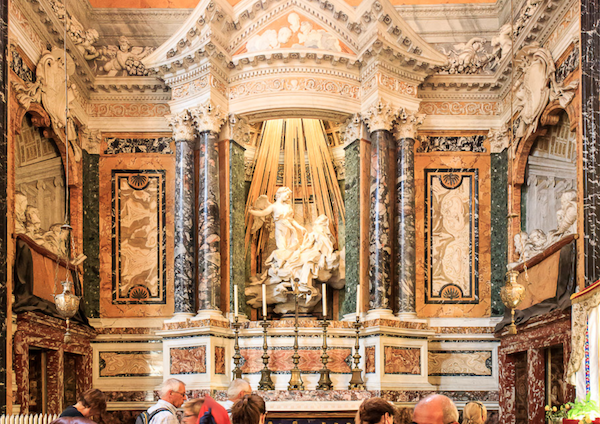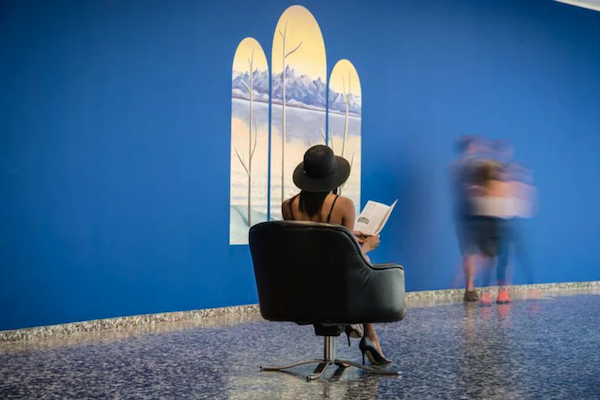To see the Goddess Durga Slaying the Demon Buffalo Mahisha you take the green train in Manhattan to the most boring neighborhood during the most boring part of the day, wait in one to three lines and pay what you wish. Take the big steps up over the Celtic art, take a U-turn right—avoiding European Painting—pass ugly gaudy Chinese vases behind glass, turn a corner left, take the right door past the massive stiff and standing Buddha, then head through two or three dim rooms, look left, then squint down at it (it’s less than six-inches tall) through the glass, while the second track of your mind tries to decide how much time to leave for Velázquez, Jean-Joseph Carriès and the rest of art history. Durga and the demon fighting frozen forever in argillite between off-white surfaces in a geometry of contained air.
To see The Ecstasy of St Teresa you take the subway to the middle of Rome, walk up a street past thin men from far away who come in very close and try to sell you things and then find a small church. There’s a donation box, an old Italian religion-woman (a nun?) or two who look at you, and there’s a laminated card, like a menu, in Italian and English and maybe some other languages, with the text of St Teresa’s confessing to being fucked by an angel’s love-arrow. There’s no line. You move down the aisle while the religion-women watch, stand some feet from Bernini’s masterpiece, boxed in by extravagant marble fixtures and take in the world’s most-well-known orgasm metaphor while the old women count seconds until you leave and they can go back to religioning.

Bernini’s Ecstasy of St. Teresa in the Cornaro Chapel of Santa Maria della Vittoria. Photo by Jeff Bondono.
Small museums have guards that track and despise you. Contemporary galleries are never near subways and there’s never more than one good thing at a time.
And throughout all of this: after getting up early there’s never any place to sit. The Hirshhorn in DC has those nice leather couches but they’re not in front of the good stuff. And: either you go alone—which means standing and looking at the thing will be better but going, coming back, and getting lunch will be worse, or you go with friends—which means it’ll be the other way around.
An artist designs an experience and life designs a counter-experience which suffuses the before and the after, and drip-feeds into the during.

Swivel chairs at the Hirshhorn Museum, DC.
I can see why people become collectors: not to own the thing but just to experience the exquisite luxury of contextlessness. Durga Slaying the Demon Buffalo as you have coffee, Durga Slaying The Buffalo Demon between paragraphs of Donald Barthelme, Durga Slaying the Demon Buffalo while Anne sets the couch on fire—the art is experienced in so many ways it becomes only itself, and there’s always parking. But who can afford it?
There’s no shortage of humanists who’ll tell you that our society undervalues art, but all the counter-experience I’ve described is a result of how valuable the art is. That value gets it taken to the worst places, put under guard, access gets controlled—and, more subtly, artificially separates the pleasure-space of art from all other pleasure: from the places we want to eat and drink and fuck. As soon as anyone decides an overgrown temple is declared sufficiently beautiful it grows tour groups, boundaries, security, visiting hours. The disease of Recognized Value can even infect an entire city: Venice—the carved, statued living-dead medieval maze, perfectly evoking centuries of life in every direction, devoid of cars and the roads that serve them so even your Amazon orders are piled up and motorboated to you under marble bridges through five-foot-wide gaps between manmade residential cliffs—and famously dull at night, and the food’s all tourist traps.
The best time to see art is the best time to buy it—when nobody cares. Try Detroit: the Packard plant looks magnificent half-demolished, the gray and graffitied pylons and floors giving way in an Akira-like deathwave, old homes with conical turrets—miniature palaces—isolated in seas of littered green, motor-psychos’ Burning Man art-cars sitting in the grocery-store lot, the Heidelberg project—Tyree Guyton’s neighborhood-sized installation—just out there mutating constantly and taking up and changing space with no entrance fees or curfew. Sometimes things get set on fire just for fun, and a lot of people won’t walk around there without a big dog or a baseball bat. But that’s life: fear and adventure, or comfort and boredom. Which side is art supposed to be on?


